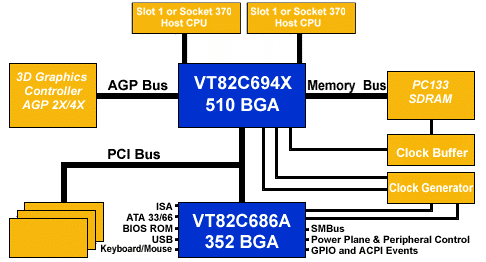VIA Apollo Pro 133A with Dual Processors
by Anand Lal Shimpi on July 13, 2000 4:25 PM EST- Posted in
- CPUs
For the longest time, running dual processors has been reserved for the high end and workstation systems, which also happen to be very expensive computers. Our perception of dual processor systems changed considerably when it was discovered that the first Celeron’s CPUs could be modified to run in SMP mode. Cashing in on this opportunity to make a truly unique product, ABIT released the BP6, the first dual processor board that ever hit the market with dual Socket-370 interfaces.
The beauty of the BP6 was that you could go out and pick up the board for under $200 as well as a pair of Celeron 300A’s that would almost definitely run at 450MHz for about $100 per chip and even less as time went on. In the end, for a little more than what a normal single processor BX setup would set you back, you could have a fairly powerful dual processor setup.
Since the release of the BP6 back in the summer of 1999, there haven’t been any products quite like ABIT’s only dual processor solution, mainly because the older Celerons have come and gone and the newer ones aren’t SMP friendly. Part of the attractiveness of the BP6 was that the CPUs that you could use with it were so cheap and very easy to overclock; now that the older Celeron is gone, it is difficult for anything to be quite as appealing as the BP6 was.
Let’s fast forward a bit to last year’s Fall Comdex in Las Vegas. Tyan gave us an interesting bit of information on a product they were working on. They let us know that the 694X North Bridge of the VIA Apollo Pro 133A chipset, a chipset we’d been playing around with for quite some time, features integrated SMP support. While the BX and GX chipsets also boast SMP support in order to enable it a motherboard manufacturer must include an external ASIC on the board itself in order to take advantage of the two processors.

Tyan saw this feature of the 694X North Bridge as an opportunity to take one of their specialties, producing dual processor workstation motherboards, and decrease the end cost by a decent amount. The first dual Slot-1 motherboard based on the VIA Apollo Pro 133A Chipset was born and dubbed the Tyan Tiger 133.
Last November, Tyan was busy ironing out some issues they were having with their Tiger 133 design, and early in 2000 we received a sample of the board; unfortunately, the board was far from stable. Later we received another revision of the Tiger 133, but once again it wasn’t stable enough to complete our usual suite of benchmarks.
But instead of Tyan being the first to get us a fully working sample, we were actually courted by another company that happened to have a similar solution that we saw at this year’s Computex in Taipei.










0 Comments
View All Comments